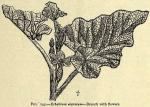555. Elaterium.
 551. ELATERIUM.—A peculiar resinous substance obtained from the fruit of Ecbal'lium elate'rium A. Richards (squirting cucumber), a vine growing in the Mediterranean regions of Europe, Africa, and Asia. The fruit, when ripe, separates suddenly from its stalk, and the internal pressure forces the juice out of the aperture thus made in a stream; in collecting, therefore, the fruits are gathered green, sliced, and the juice expressed by slight pressure; on standing it deposits a sediment, which, when dried, forms the commercial Elaterium.
551. ELATERIUM.—A peculiar resinous substance obtained from the fruit of Ecbal'lium elate'rium A. Richards (squirting cucumber), a vine growing in the Mediterranean regions of Europe, Africa, and Asia. The fruit, when ripe, separates suddenly from its stalk, and the internal pressure forces the juice out of the aperture thus made in a stream; in collecting, therefore, the fruits are gathered green, sliced, and the juice expressed by slight pressure; on standing it deposits a sediment, which, when dried, forms the commercial Elaterium.
Elaterium is in flat pieces of varying sizes, light and friable, pale green when fresh, but taking on a gray or light buff color as it becomes older; the surface is covered with small crystals of elaterin; odor somewhat tea-like; taste acrid and intensely bitter, due to the active ingredient, elaterin, which constitutes from 25 to 30 per cent. of the drug. This principle is insoluble in water, readily soluble in chloroform and hot alcohol; it is a violent irritant poison; its alcoholic solution is colored red by warm sulphuric acid; its carbolic acid solution, crimson, rapidly changing to scarlet. There is also present ecballin (soft, yellow, acrid), hydroelaterin, and elaterid.
ELATERINUM (U.S.P. IX).—Elaterin.—Exhaust elaterium with chloroform; add ether; white crystals deposit immediately. Wash with ether and recrystallize from chloroform. This principle is odorless and crystalline, is bitter and acrid in taste. No weighable ash remains on incinerating 0.1 Gm. of Elaterin.
ACTION AND USES.—Elaterin is a powerful hydragogue cathartic, used in the treatment of dropsy. Dose: 1/20 to 1/12 gr. (0.003 to 0.005 Gm.). Preparation: Trituratio Elaterini (10 per cent.). Dose: ½ gr. (0.030 Gm.).

